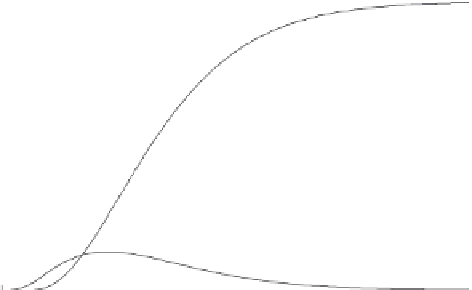Geoscience Reference
In-Depth Information
1
0.8
y
0.6
(cm h
−
1
)
0.4
2
0.2
1
0
0
5
10
t (h)
Fig. 12.5 Construction of the half hour unit hydrograph from the S hydrograph example developed in
Figure 12.4. Two S hydrographs are time-shifted by an amount
D
u
=
0
.
5 h and then the difference
between their ordinates is determined; this result (thin line 1) simulates the outflow rate from the
catchment, caused by a uniform input rate of
x
=
1.0 cm h
−
1
lasting for 0.5 h. The unit hydrograph for
a total input volume of unit magnitude of 1 cm (heavy line 2) is obtained by multiplying this difference
by 1
/
D
u
=
2.
S hydrograph can be used to derive a unit hydrograph of any unit time period
D
u
.Ifthe
unit hydrograph is sought for a unit period of, say,
D
u
=
5 h, the operation described by
Equation (12.1) is performed. As illustrated in Figure 12.5, first an S curve, time-shifted
by half an hour, is subtracted from the original one. An input rate of
x
0
.
1cmh
−
1
lasting
for half an hour produces a total volume of 0.5 cm. Therefore this difference must be
scaled by multiplying it by 1
=
D
u
=
/
2, to obtain a unit runoff volume of 1 cm.
The instantaneous unit hydrograph
This is the outflow hydrograph resulting from an input of unit volume placed instanta-
neously and uniformly over the entire catchment surface, again under the assumptions of
linearity and time-invariance. Clark (1945) was probably the first to apply this concept
in runoff computations. As shown in the Appendix, an instantaneous input can be repre-
sented by a Dirac delta function. Hence the instantaneous unit hydrograph is in fact the
impulse response or Green's function of the catchment. In the notation of the Appendix,
it can be represented by
u
u
(
t
). It also means that the outflow from the catchment, in
response to a uniform rainfall input of intensity
x
=
x
(
t
), can be obtained by means of
the convolution integral, in any one of the forms (A11)-(A16), whichever is appropriate.
For instance in the case of Equation (A14) this is
=
t
y
(
t
)
=
x
(
τ
)
u
(
t
−
τ
)
d
τ
(12.2)
0
in which
y
=
y
(
t
) is the output,
x
=
x
(
t
) the input, and
u
=
u
(
t
) the unit response of
the catchment. Recall that
y
=
y
(
t
) is the storm runoff rate per unit area of catchment;
































































